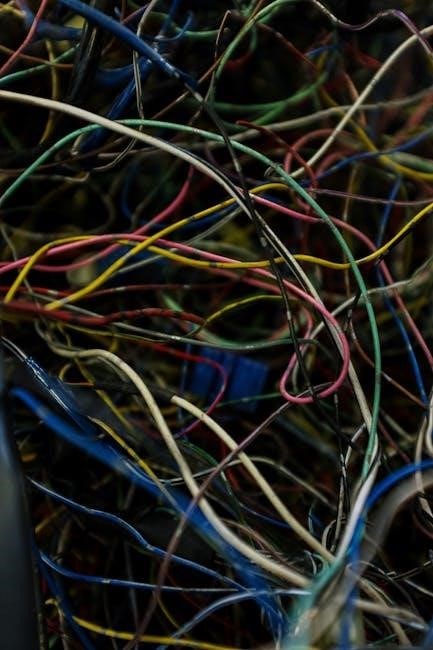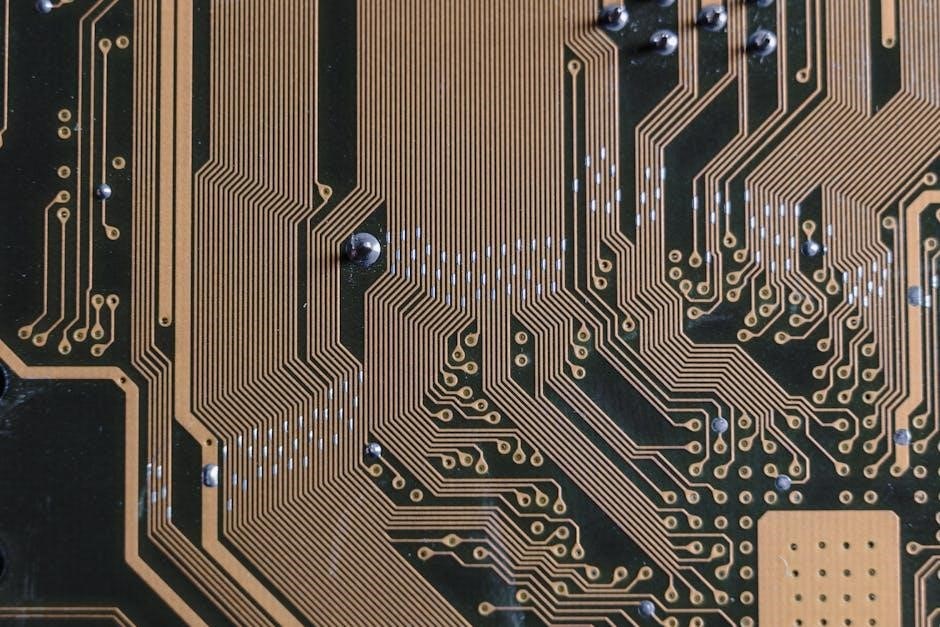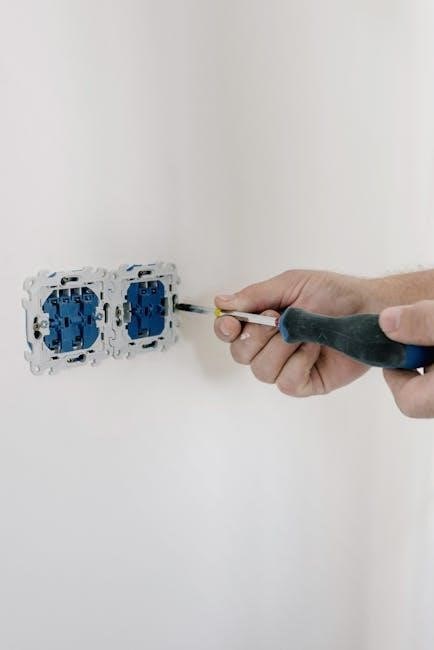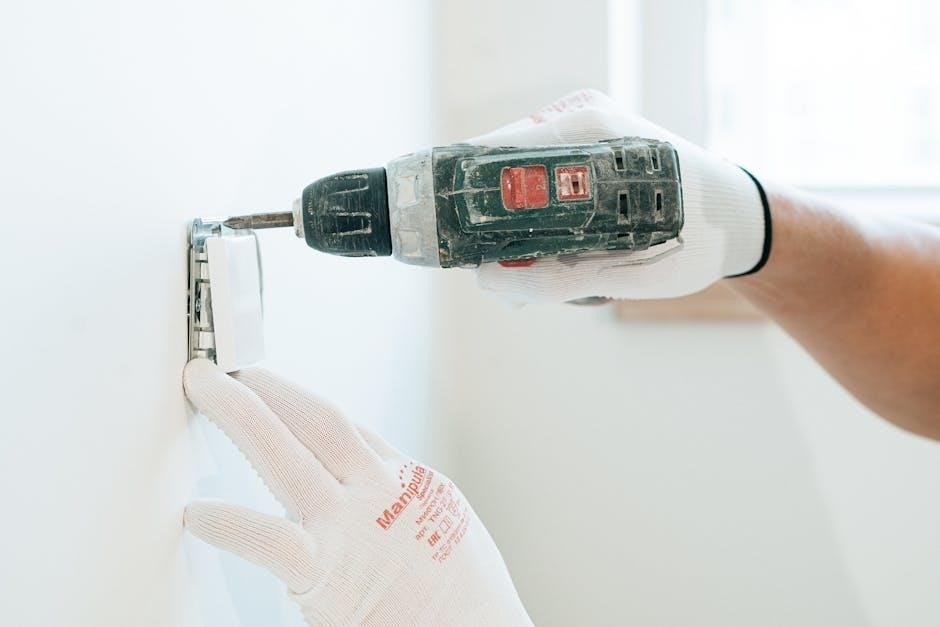DMX wiring is a standardized control system for lighting and stage equipment, enabling precise communication between controllers and devices. It uses twisted-pair cables to ensure reliable signal transmission.
1.1. What is DMX and Its Importance in Lighting Systems
DMX (Digital Multiplex) is a standardized communication protocol for controlling lighting and stage equipment. Based on the EIA-485/RS-485 standard, DMX enables centralized control of up to 512 channels, ensuring synchronized lighting effects. Its importance lies in its ability to reliably transmit digital signals over long distances using twisted-pair cables. DMX is essential for modern lighting systems, providing precise control over fixtures, dimmers, and effects, making it indispensable in theatrical, concert, and architectural lighting setups.
1.2. Brief Overview of DMX Wiring Basics
DMX wiring involves using twisted-pair cables to transmit digital control signals between devices. The system relies on 5-pin XLR connectors, with specific pin assignments for data transmission. Proper wiring ensures reliable communication, while incorrect connections can cause signal loss. Twisted-pair cables reduce noise, and shielding protects against interference. DMX wiring is based on the RS-485 standard, enabling long-distance signal transmission without degradation. Understanding these basics is crucial for designing and installing efficient DMX lighting control systems.
DMX Cable Types and Specifications
DMX cables feature twisted-pair conductors to reduce noise and ensure reliable signal transmission. Shielded cables are recommended to prevent interference. They must meet RS-485 standards for optimal performance.
2.1. Understanding Twisted Pair Conductors
Twisted pair conductors in DMX cables consist of two wires twisted together to minimize electromagnetic interference. This design ensures signal integrity over long distances, reducing noise and crosstalk. The twisting cancels out external electromagnetic fields, preserving data transmission quality. Shielded cables further enhance this by adding a protective layer, making them ideal for DMX systems. Properly twisted pairs are crucial for maintaining reliable communication between controllers and lighting fixtures, ensuring accurate signal delivery and consistent performance in professional lighting setups.
2.2. Importance of Shielded Cables for DMX Systems
Shielded cables are essential for DMX systems to prevent electromagnetic interference (EMI) and radio-frequency interference (RFI). The shielding acts as a protective barrier, minimizing signal degradation and ensuring reliable data transmission. Without shielding, the DMX signal can be disrupted, leading to errors in lighting control. The shielded design maintains signal integrity, especially in noisy environments, making it critical for professional lighting installations. Always use high-quality shielded cables to avoid signal loss and ensure consistent performance in DMX networks.
2.3. Differences Between DMX and Other Control Cables
DMX cables differ from other control cables due to their twisted-pair design and shielding, which minimize interference. Unlike audio or power cables, DMX cables transmit digital control signals at a higher baud rate, requiring precise wiring. They are specifically designed for RS-485 communication, ensuring reliable data transmission in lighting systems. Avoid using non-DMX cables, as they may lack the necessary shielding and proper conductor arrangement, leading to signal degradation and system malfunctions. Always use DMX-dedicated cables for optimal performance.

DMX Wiring Diagrams and Connectors
DMX wiring diagrams outline connections between controllers, fixtures, and receivers using standard 5-pin XLR connectors. These diagrams ensure proper signal flow and compliance with USITT standards.
3.1. Standard 5-Pin XLR Connectors for DMX Systems
Standard 5-pin XLR connectors are the backbone of DMX systems, ensuring reliable communication between controllers and lighting fixtures. Each pin is assigned specific functions: Pin 1 for ground, Pin 2 for data 1, Pin 3 for data 2, with Pins 4 and 5 reserved for future use. Proper termination is crucial to prevent signal degradation, typically achieved using a 120-ohm resistor. These connectors are widely compatible and adhere to USITT standards, making them indispensable in professional lighting setups.
3.2. Wiring Diagram for a Typical DMX Universe
A typical DMX universe consists of a controller connected to multiple fixtures via a daisy-chained DMX cable. The controller sends signals through the cable, which loops from one fixture to the next. Each fixture extracts the necessary data while passing the signal along. Proper termination at the end of the chain is essential to prevent signal reflection. This setup ensures reliable communication across the lighting system, adhering to DMX512 standards for consistent performance.
3.3. Connector and Pin Assignments According to USITT Standards
DMX connectors follow the USITT standards, typically using 5-pin XLR connectors. Pins 1 and 3 carry the differential signal, while Pins 2 and 4 are unused. Pin 5 is reserved for future use. Proper pin assignment ensures reliable signal transmission, adhering to DMX512 protocol. This standardization guarantees compatibility across devices, preventing signal degradation and ensuring consistent communication in lighting systems.

Best Practices for DMX Installation
Ensure proper termination, use high-quality twisted-pair cables, and avoid mixing DMX with power wiring. Loop-through connections and correct pin assignments are crucial for reliable signal transmission.
4.1. Loop-Through Wiring Method for Multiple Fixtures
The loop-through method connects DMX fixtures in a daisy-chain configuration, ensuring each device receives and retransmits the control signal. Start at the controller, wire to the first fixture’s DMX input, then connect its DMX output to the next fixture’s input. This creates a single continuous line, minimizing signal degradation and ensuring all fixtures receive the correct data. Proper termination at the end of the chain is essential to prevent signal reflection and interference. This method simplifies installations and maintains system reliability.
4.2. Avoiding Common Errors in DMX Cable Installation
Common errors in DMX cable installation include using incorrect cable types, such as unshielded or non-twisted-pair cables, which can cause signal interference. Improper termination at the end of the DMX line can lead to signal reflection and data corruption. Additionally, mixing DMX cables with power cables in the same conduit can introduce noise. Always use shielded, twisted-pair DMX cables and ensure proper termination to maintain signal integrity. Testing the cable before installation and following industry standards can help prevent these issues and ensure reliable system performance.
4.3. Proper Termination of DMX Lines
Proper termination of DMX lines is crucial to prevent signal reflection and data loss. A termination resistor should be installed at the end of the DMX line to absorb the signal, ensuring clean data transmission. The resistor should be 120 ohms, matching the cable’s impedance. Improper or missing termination can cause signal degradation and communication errors. Always terminate the DMX line correctly to maintain reliable performance across all connected devices, ensuring smooth operation of your lighting system.
Safety Guidelines for DMX Wiring
Always turn off power before installation to prevent electrical shock. Handle exposed wires carefully and ensure dry conditions. Proper safety measures protect both equipment and personnel.
5.1. Risk of Electrical Shock and Prevention Measures
Electrical shock is a significant risk during DMX wiring. To prevent this, always turn off the main power supply before starting any installation. Ensure your hands are dry and avoid touching exposed wires. Proper insulation and secure connections are critical to minimize shock hazards. Following these precautions protects both personnel and equipment from potential damage. Adhering to safety guidelines ensures a safe and reliable DMX system installation. Always prioritize caution when working with electrical systems to avoid accidents.
5.2. Importance of Turning Off Power Before Installation
Turning off the power before DMX installation is crucial for safety and system protection. It prevents electrical shock, ensuring personnel safety during wiring. Power surges or live circuits can damage equipment, so disconnecting power minimizes this risk. Always verify the power is off using a voltage tester. This precaution ensures a safe working environment and prevents potential damage to DMX controllers or fixtures. Proper shutdown protects both the installer and the equipment, making it a critical step in any DMX wiring project. Always follow safety protocols to avoid accidents and ensure reliable system operation.
5.3. Handling Exposed Wires Safely
Handling exposed wires in DMX systems requires caution to prevent electrical shock. Always ensure power is off and verify with a voltage tester. Use insulated tools to avoid direct contact with live wires. Keep hands dry and avoid touching wires in humid environments. Never handle exposed wires near open flames or sparks. If wires are damaged, replace them immediately to prevent short circuits. Proper grounding and secure connections are essential for safety. Follow these precautions to protect yourself and maintain system integrity during installation or troubleshooting.

Troubleshooting DMX Wiring Issues
Common DMX wiring issues include signal loss, incorrect termination, and interference. Check connections, ensure proper termination, and use diagnostic tools to identify and resolve faults efficiently.
6.1. Common Problems in DMX Signal Transmission
Common issues in DMX signal transmission include signal loss, interference, and incorrect termination. Faulty cables, improper connections, or damaged connectors can disrupt communication. Noise from nearby devices or unshielded cables may also degrade signal quality. Additionally, termination issues, such as missing or incorrect terminators, can cause reflection and signal degradation. These problems often result in erratic behavior, flickering lights, or complete loss of control. Identifying and addressing these issues promptly is crucial for maintaining reliable DMX system performance.
6.2. Tools and Techniques for Diagnosing Wiring Faults
Diagnosing DMX wiring faults requires specific tools and techniques. A multimeter is essential for measuring voltage and continuity, while DMX-specific testers can verify signal integrity. Cable testers can identify short circuits or open lines. Visual inspections and signal analyzers help pinpoint issues like noise or degradation. Techniques include checking pin assignments, verifying proper termination, and testing individual cables. These tools and methods ensure accurate troubleshooting, helping to isolate and resolve faults efficiently.
6.3. Solutions for Interference and Signal Loss
To address interference and signal loss in DMX wiring, use shielded cables to block electromagnetic interference. Ensure proper termination with 120-ohm resistors to prevent signal reflection; Avoid running DMX cables near power lines or high-voltage equipment. Use twisted-pair conductors to minimize noise. Implement signal boosters or repeaters for long cable runs. Verify correct pin assignments and connections to maintain signal integrity. Regularly test cables and replace damaged ones to ensure reliable performance. Proper installation and cable management are key to preventing signal degradation.

Additional Resources and References
Explore downloadable DMX wiring guides, manuals, and tools for cable preparation. Join online forums and communities for expert advice and troubleshooting tips to enhance your understanding and installation skills.
7.1. Downloadable DMX Wiring Guides and Manuals
Access comprehensive DMX wiring guides and manuals online, offering detailed diagrams and step-by-step instructions. These resources cover cable specifications, connector assignments, and troubleshooting tips. For instance, the DMX512 CABLE, 5-PIN guide provides full pin assignments according to USITT standards. Additionally, manufacturer-specific manuals, like the Solid Apollos Wireless Transmitter/Receiver guide, ensure compatibility and optimal performance. Download these materials to streamline your installation process and maintain system reliability.
7.2. Recommended Tools for DMX Cable Preparation
Essential tools for DMX cable preparation include wire cutters, strippers, and crimpers for XLR connectors. A cable tester ensures signal integrity, while a multimeter helps troubleshoot connections. Proper tools guarantee reliable terminations, preventing signal loss. Additionally, cable management tools like ties and labels organize installations, enhancing maintainability. Always use high-quality tools to ensure precise connections and maintain DMX system performance standards.
7.3. Online Communities and Forums for DMX Support
Active online communities and forums provide invaluable support for DMX wiring challenges. Platforms like ControlBooth, Lighting Forums, and specialized Facebook groups host discussions among professionals and hobbyists. These forums offer troubleshooting tips, design advice, and best practices. Many include downloadable resources, such as wiring diagrams and manuals. Engaging with these communities ensures access to real-world experiences and expert guidance, making them indispensable for resolving complex DMX installation issues and optimizing system performance.
